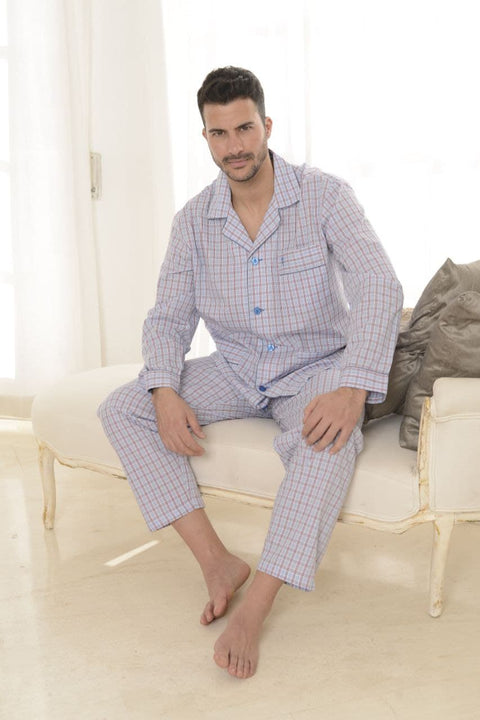Any old t-shirt, sweatpants or torn boxers have been declared the favorite pajama set for sleeping or staying comfortable at home. This is how men dress today, after leaving behind their childhood soccer pajamas. But really, the beginnings of pajamas really started in a very different way, and it has taken a turn that is totally worth evaluating and talking about how this piece of clothing is seeking to vindicate itself.
Contemporary men have adopted the same pattern of behavior when it comes to wearing pajamas: they tend to combine an old shirt with shorts. And a 2004 survey by ABC News found that only 13 percent of men wore clothing intended for lounging, but even so, this percentage was plummeting.
And what happened to the pajamas?
So, we have to start asking ourselves: What happened to the pajamas? What is known about those two-piece garments that, in case you didn't know, provide endless benefits at bedtime?
Well, according to historians in the world of textile manufacturing, they assure that pajamas are not dead. Currently, somewhere in the world, pajama sets are selling at a high price. Of course, there are also cheaper options, but whether men use them or not is a different issue.
Here, a study by the pajama company Sleep Jones has revealed that only half of its customers wear their pajamas to bed.
“ Pajamas are a fashion statement now,” say fashion and design experts at The New School. They add that they are still part of men's wardrobes; The only difference is that these clothes are more likely to be found in the closet of those upper-class citizens, while average middle-class young people opt for the so famous old shirt and boxers.
Beginnings of Pajamas: Like it was before?
It's funny, because that's how they started the pajama scene in the beginning. Originally, pajamas come from Indian fashion. During the days of the British period, the colonists observed lightweight drawstring pants and agreed that they looked quite comfortable and very good, so they took them to England with them.
Therefore, among the upper class, pajamas would be combined with a jacket to avoid wearing a nightgown.
Previously, men and women used the same thing to go to sleep. On the one hand, we saw a nightgown that extended almost to the floor. Meanwhile, for the lower class, we observed the same garment, but it tended to be a little shorter since it could be the same shirt they wore to work during the day.
"Some time later, we would see what is known as the 'bathrobe'. This outfit became a popular garment among the wealthy who often gathered at home with their family and friends. They were designed with beautiful fabrics and included intricate designs, thus becoming a status symbol throughout Europe and America."
At this knit, for the lower class, the nightgown continued to be their main sleepwear until a few decades into the 20th century, as it was the warmest way to dress at home before central heating. The high collar, wide sleeves, and mid-calf or slightly longer length would be the most viable option for staying warm, unlike two-piece sets. It wouldn't be until 1920 that pajamas would begin to broaden their horizons among mainstream trends.
Once central heating was imposed, sleepwear suddenly had a different focus and was now seen as a matter of fashion, rather than practical, and designs began to reflect various trends. Although at first there was a lot of influence from Middle Eastern design, later, during the 1930s, we saw more pajamas with a more regal look, inspired above all by Russian military clothing.
50s decade
By 1950, the elegant pajamas that set the trend were being replaced by garments with more comfortable and informal styles made from elastic knit fabrics on top and finer cotton cloth trousers. With this, basically, with cheaper fabrics came greater accessibility, marking the death of the nightgown.
As time went by, not only did the fabrics evolve, but also the imposed colors; stripes, polka dots, and any other type of designs made their way into pajamas. Furthermore, with the rise of radio and later television, this trend was fueled and there was much talk about what to wear for lounging at home.
From the 70s to the 80s
The 1970s saw a resurgence of grandpa nightgowns and shiny satin robe sets. This decade also marked the curious trend of multipurpose clothing that could be used both at work and at the club. Next, sports clothing emerged, clothing that was intended to be worn in the gym, hit the streets, especially during the 1980s and beyond.
The dress code had already been greatly altered and the pajama set would become a casualty. By the 1950s and 1960s, a working-class man could come home and fall into a routine quite close to that of an aristocrat, in which he would take off his suit and put on a more comfortable sweater, before changing for bed. .
However, as the pace of life quickened, the popularity of wearing pajamas was declining. From the 1970s and 1980s onwards, men were more likely to come home straight into a pair of sweatpants or shorts and had no more reason to change after that.
Nowadays we see a much more accelerated lifestyle, where we eat dinner in front of the television and talk on the phone while in the bathroom, thus breaking all kinds of rules of decorum.
Expert opinion
While some experts talk about the decline of known conventional norms, designers point to it as the rise of democracy. As a more open society develops and the walls of class crumble, along with pomp and formality.
Perhaps, then, in a time where they perceive the erosion of democracy, pajamas could return? Well, today within the fashion industry, there is something called “the return of elegance”, where we see how formality returns when dressing.
For years, men's fashion runways have been walked by men in hoodies and sweatpants, but as an antidote to that, some designers have chosen to go the other way. Perhaps you see a future in another direction and you may revive that more formal outfit.
"After this reflection, our purpose has always been for you to find in our pajamas the ideal garment for staying at home and for sleeping. Don't hesitate, visit our website El Búho Nocturno and you will understand."

